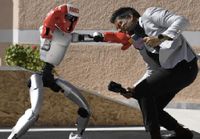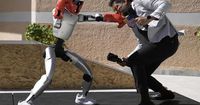At Ancient Olympia, the hallowed birthplace of the Olympic Games, history took a futuristic twist this week as humanoid robots competed in the International Humanoid Olympiad. Over four days, these machines shuffled, kicked, boxed, and drew back bows, all under the watchful eyes of children, engineers, and curious onlookers. The event, organized by Greek academic and startup founder Minas Liarokapis, was more than just a spectacle—it was a candid assessment of where robotics stands today, and where it might be headed tomorrow.
Robots took to the soccer field with jerky determination, sometimes freezing mid-match for a quick battery change. They wowed young spectators by mimicking shadow-boxing moves and managed to shoot arrows across makeshift ranges. As reported by AP News, these feats, while impressive, also highlighted the current limits of humanoid robotics. The organizers deliberately avoided more challenging Olympic staples like discus or javelin throws, opting instead for tasks robots could realistically attempt. "We were trying to get the discus and the javelin, but that’s tough for humanoid robots," admitted Patrick Jarvis, co-founder of robot maker Acumino. "We also can’t say whose robot can do a high jump because you’d have to build special legs … and that’s not necessary for most humanoid robots."
While artificial intelligence has made dazzling strides—think ChatGPT and beyond—its physical cousins are lagging far behind. According to the journal Science Robotics, humanoid robots are “100,000 years behind AI” when it comes to learning from data. The main culprit? A lack of training material. Whereas AI can feast on the endless banquet of digital data online, humanoid robots require real-world, physical data that is slow, expensive, and tricky to collect.
Minas Liarokapis, the driving force behind the Olympiad, has a clear vision for the future. "I really believe that humanoids will first go to space and then to houses … the house is the final frontier," he told AP News. But he’s not making any wild promises about timing. "To enter the house it’ll take more than 10 years. Definitely more. I’m talking about executing tasks with dexterity, not about selling robots that are cute and are companions." In other words, the era of robots tidying up closets or washing dishes is still at least a decade away.
Despite these hurdles, there’s a palpable sense of momentum in the field. Luis Sentis, professor of aerospace engineering and engineering mechanics at The University of Texas at Austin—and co-founder of humanoid maker Apptronik—was upbeat about the pace of progress. "These synergies are happening very, very quickly. So I do see these problems being cracked on a day-to-day basis," Sentis observed. He emphasized the importance of collaboration between researchers, data companies, and major manufacturers, noting that billions of dollars are now flowing into humanoid robotics.
The event in Olympia was also a showcase for innovation. Aadeel Akhtar, CEO and founder of advanced prosthetics company Psyonic, demonstrated a bionic hand that can provide sensory feedback. This technology, Akhtar explained to The Associated Press, offers a unique bridge between human and robot capabilities. "We’ve built our hand for both humans and robots," he said. "So we’re closing that gap by actually using the hand of the prosthetic on humans and then translating that (data) over to robots." The hope is that such data can accelerate the development of robots able to handle delicate, real-world tasks.
Another frontier is the merging of biology and computing. Hon Weng Chong, CEO of Australian biotech firm Cortical Labs, described efforts to develop a "biological computer" using real brain cells grown on a chip. These cells can learn and respond to information, potentially teaching robots to think and adapt more like humans. It’s a bold vision, but one that could redefine what machines are capable of in the years ahead.
The Olympiad itself is intended to become an annual benchmark for progress. "Organizers hoped to lay a foundation for annual competitions providing an ‘honest validation of the progress that has been made in humanoid robots,’" Jarvis noted. By limiting events to what robots can actually do—and not what we wish they could do—the event provides a reality check for the industry and the public alike.
There’s also an intriguing international dimension to the story. According to The Independent, Chinese companies are increasingly eager to showcase their humanoid robots at public events, such as Beijing’s first Humanoid Robot Games in August. U.S. companies, by contrast, tend to stick to polished promotional videos, which can sometimes mask failures. Still, there are notable exceptions. Elon Musk’s Tesla unveiled its Optimus prototype in 2022, which managed to walk, turn, and wave to a cheering crowd—albeit a bit stiffly. Boston Dynamics, meanwhile, has wowed audiences with its dog-like Spot robots, which danced in synchrony to a Queen song on "America’s Got Talent." One of the robots broke down mid-performance, prompting judge Simon Cowell to remark, "Can I be honest with you? I actually think — I don’t mean this in a cruel way — it was weirdly better that one of them died. Because it showed how difficult this was."
The Olympiad’s organizers, including Liarokapis and Jarvis, made it clear that the event was about more than just entertainment. It was about setting an honest benchmark for what humanoid robots can do today, and what they might achieve tomorrow. While the robots’ movements may still be awkward and their skills limited, the energy and ambition on display suggest that the field is anything but stagnant.
For now, the dream of a robot that can tidy up after us, cook dinner, or even just reliably fetch the mail remains just that—a dream. But as the Olympiad in Ancient Olympia showed, the race is on, and the world’s brightest minds are determined to close the gap between science fiction and reality. The next decade promises plenty of surprises, and perhaps, a few more robots on the winner’s podium.





